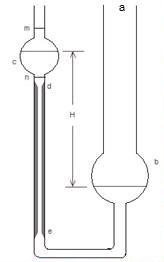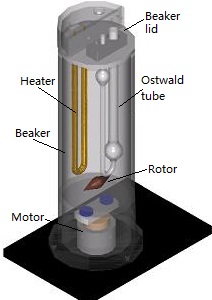
Principle of capillary method

Schematic of apparatus
Features
Innovative apparatus construction
Temperature variable and controllable
Ideal for bio/medical physics teaching
Introduction
Viscosity is a critical property of liquids, describing their internal friction and resistance to flow. Accurate measurement of viscosity is essential in a variety of applications, from industrial processes to health diagnostics. For instance, changes in blood viscosity can significantly affect blood flow and are often linked to cardiovascular conditions. Thus, measuring the viscosity of bodily fluids like blood can provide important insights into human health.
The LEMI-35 Apparatus utilizes the Ostwald viscometer, a device widely used in laboratories for determining the viscosity of liquids through the capillary flow method. By measuring the time taken for a liquid to pass through a narrow capillary tube under the influence of gravity, this apparatus provides precise viscosity measurements for small liquid volumes, making it ideal for research and educational purposes.
The LEMI-35 Apparatus allows users to perform the following experiments:
1. Understand Poiseuille’s Law: Investigate how the flow of a liquid through a capillary tube is affected by factors such as the liquid's viscosity, the tube's dimensions, and the pressure driving the flow.
2. Measure Viscosity Coefficient Using the Ostwald Viscometer: Use the Ostwald viscometer to calculate the viscosity coefficient of different liquids by measuring the time it takes for the liquid to flow through the capillary tube under controlled conditions.
3. Measure Surface Tension Coefficients: In addition to viscosity, explore how the liquid's surface tension can be determined through capillary rise experiments.
This apparatus provides students with the opportunity to:
1. Learn how to use the Ostwald viscometer and understand the principles behind capillary flow.
2. Gain insight into the mathematical relationships that govern the flow of fluids through narrow tubes, specifically the Poiseuille law.
3. Develop an understanding of the practical applications of viscosity measurements in fields like biophysics and industrial processes.
4. Experiment with different liquids and observe how viscosity correlates with molecular structure and environmental factors like temperature.
The instruction manual provides clear experimental setups and step-by-step instructions for performing each experiment, detailed explanations of the principles of fluid dynamics, Poiseuille’s law, and the capillary method of viscosity measurement, and example results and guidance on interpreting experimental data to calculate viscosity and surface tension.
For a deeper understanding of fluid dynamics, viscosity measurement techniques, and their real-world applications, refer to the Experiment Theory and Contents. The LEMI-35 Apparatus of Measuring Liquid Viscosity - Capillary Method is an invaluable tool for students and researchers looking to explore the properties of liquids in both basic and applied scientific fields.
Specifications
| Description | Specifications |
| Temperature controller | Range: room temperature to 45 °C; resolution: 0.1 °C |
| Stopwatch | Resolution: 0.01 s |
| Motor speed | Adjustable, power supply 4 V ~ 11 V |
| Ostwald viscometer | Capillary tube: inner diameter 0.55 mm, length 102 mm |
| Beaker volume | 1.5 L |
| Pipette | 1 mL |
Part List
| Description | Qty |
| Controller | 1 |
| Glass beaker | 1 |
| Lid of beaker (W/ heater, sensor, capillary holder & wire sockets) | 1 |
| Magnetic rotor | 1 |
| Ostwald tube | 2 |
| Rubber air pump | 1 |
| Connection wire | 2 |
| Stopwatch | 1 |
| Pipette | 1 |
| Manual | 1 |

Principle of capillary method

Schematic of apparatus